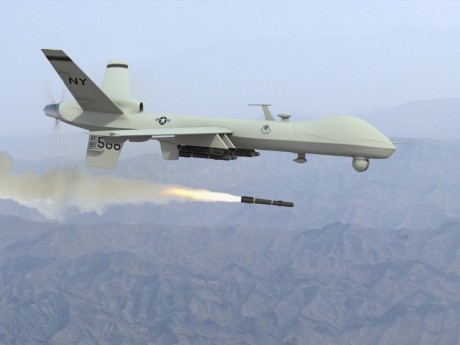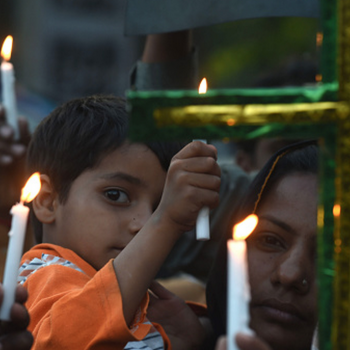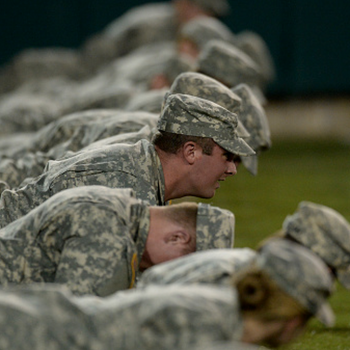I must confess, I’m puzzled by Christian outrage at our drone campaign — the most precise aerial bombardment in the history of warfare. In general, the rhetoric casts far more heat than light. One hears words like “indiscriminate” (manifestly false), “assassinations” (by that measure, what airstrike isn’t an ‘assassination’?), and “war by joystick” (are stand-off attacks now immoral?), but these words and phrases aren’t a moral argument. While I can understand better the argument that drones also kill civilians, there is no method or form of modern warfare that doesn’t kill civilians, and the military alternatives to drone strikes, such as conventional aerial bombardment or raids by ground troops, would endanger just as many — and often more — civilians as the drone strikes.
But if one backs up and drills down deeper into the opposition to drone strikes, one typically finds either pacifism, a denial of a state of war (in other words, viewing our actions against terrorists as law enforcement, not war), or a subtle combination of both. In this post, I’m not speaking to the pacifists among us. There is literally no means or method of warfare that meets with pacifist approval. But for those who aren’t pacifists, the legal and moral analysis requires an answer to two broad questions:
(I) Are we lawfully and appropriately engaged in a state of war? The phrase used to describe the “right to war” is jus ad bellum, and its parameters have been debated for hundreds of years — from Augustine to Aquinas to the Salamanca. While the precise parameters of Christian just war theory are too complex for this blog post, suffice to say that the horror of modern warfare has led to an extension of jus ad bellum into a doctrine known as jus contra bellum, an effort to ban or prohibit all war. The U.N. Charter — the primary document governing the legal right to wage war by nation-states — falls more on the jus contra bellum side of the spectrum, banning aggressive warfare between nation-states. Article 2 of the Charter states:
- The Organization is based on the principle of the sovereign equality of all its Members.
- All Members, in order to ensure to all of them the rights and benefits resulting from membership, shall fulfill in good faith the obligations assumed by them in accordance with the present Charter.
- All Members shall settle their international disputes by peaceful means in such a manner that international peace and security, and justice, are not endangered.
- All Members shall refrain in their international relations from the threat or use of force against the territorial integrity or political independence of any state, or in any other manner inconsistent with the Purposes of the United Nations.
Yet the charter doesn’t mandate pacifism. Article 51 contains an important exception to this broad ban on “the threat or use of force”:
Nothing in the present Charter shall impair the inherent right of individual or collective self-defence if an armed attack occurs against a Member of the United Nations, until the Security Council has taken measures necessary to maintain international peace and security. Measures taken by Members in the exercise of this right of self-defence shall be immediately reported to the Security Council and shall not in any way affect the authority and responsibility of the Security Council under the present Charter to take at any time such action as it deems necessary in order to maintain or restore international peace and security.
Unquestionably, the United States has suffered armed attacks from terrorist enemies, and it continues to suffer armed attacks. While Americans had been repeatedly attacked by al Qaeda (sheltered and supported by the Afghan government) prior to September 11, 2001, the United States only launched a formal state of war in the aftermath of 9/11. The broad — and overwhelmingly passed — Authorization for Use of Military Force states:
(a) IN GENERAL- That the President is authorized to use all necessary and appropriate force against those nations, organizations, or persons he determines planned, authorized, committed, or aided the terrorist attacks that occurred on September 11, 2001, or harbored such organizations or persons, in order to prevent any future acts of international terrorism against the United States by such nations, organizations or persons.
While there are some who believe that the declaration was unwise and that law enforcement measures would be more appropriate in response to 9/11, as a matter of international and domestic law, we are in a state of “armed conflict.” I have yet to hear a coherent non-pacifist, distinctly Christian argument that the terrorist attacks of 9/11 were not acts of war and that America was not entitled to invoke its rights under international law to defend itself. In other words, we’re not engaged in a law enforcement effort to reign in a mafia but instead a state of war to defeat a national enemy.
(II) If we are lawfully at war, are conducting the war lawfully? First, a bit of history. Scriptures contain surprisingly few guidelines for the conduct of war itself (indeed, God even mandated total war on the Canaanites), but following the horror of the Wars of Religion in Central Europe, the battered nation-states of the West began to develop a doctrine of jus in bello — right conduct within war. The goals of this developing body of law were laudable: if war could not be avoided, assure that only combatants suffer its consequences. Armies should not target civilians, they should not target civilian structures, and if combatants are disabled by wounds or captured, they should be cared for. Out of these doctrines sprang the romanticized vision of 18th Century warfare — two colorfully-uniformed armies fighting on an open field in a “gentlemen’s contest” until one force gave way. While this ideal of war began to crack during the French Revolution and Napoleonic eras (where the levée en masse mobilized the bulk of young French manhood for war), it crumbled away almost completely during the Civil War. Because Southern society mobilized so completely to support and sustain large armies (despite a much smaller population relative to the North), it became an object of Union warfare to destroy the South’s very ability to wage war. Thus, Sherman’s famous March to the Sea. Total mobilization met total war.
This principle continued through World War I and (despite post-war efforts at reform and limitation) into the unprecedented carnage of World War II, when the world’s most powerful nations pulled the near-entirety of their human, agricultural, and industrial capital into a struggle for survival. It’s a time we can scarcely now comprehend, when city-wide air strikes were the norm and fighting raged house to house, city-to-city without regard to the niceties of 18th century combat.
Shocked by a war far more destructive than the Wars of Religion, the international community once again endeavored to place effective limits on armed conflict — limits which survive today and govern American military forces. In sum, American forces are limited by the principles of necessity, distinction, and proportionality.
“Necessity” or “military necessity” simply means that armed forces should limit their attacks to accomplish legitimate military objectives. The central idea of “distinction” is to attack only military targets. Finally, “proportionality” prohibits the use of force greater than required to achieve a military objective. It does not mean fighting with equivalent weapons (you can bring a bomb to a gunfight — and I’d in fact encourage that). Critically, military forces are also required to aid compliance with these principles by — among other things — avoiding use of civilian facilities, and wearing distinctive uniforms to assist in “discriminating” between military and non-military targets. If an armed force tries to blend in with the civilian population and uses protected sites (such as churches, mosques, hospitals, etc.) for military purposes, then it is violating the laws of war. Al Qaeda, its various affiliates and offshoots, and the Taliban violate the law of war intentionally and strategically.
In such circumstances, the requirement — in particular — of “distinction” is not unilateral and absolute. In other words, the enemy’s failure to use uniforms and its persistent use of civilian buildings gives us greater latitude in the use of force, not lesser. To be sure, we should do what we can to make sure that we’re engaging militants and not civilians, but the moral and legal responsibility for civilian deaths (assuming we are not grossly negligent or reckless) falls on the disguised militants,not on the uniformed Americans. Here’s a concrete example: When I was in Iraq, it was well-known that al Qaeda would use a certain kind of civilian truck to carry and detonate VBIEDs (vehicle-borne IEDs). They would dress like common farmers or merchants, drive up to Iraqi or American outposts, and detonate the vehicle. As a consequence, we put in place elaborate procedures to try to stop vehicles far from our outposts and steer them a safe distance away. One evening, a truck matching the exact description of a truck on our “BOLO” list (“be on the lookout”) came speeding towards one of our facilities. The driver ignored hand signals, he ignored warning flares, and a soldier then fired a single shot into the engine block to stop the truck. The bullet ricocheted off the target and straight into the heart of a young father of six — a completely innocent young father of six — who had been merely listening to the radio and driving, oblivious, to all the warnings around him. To make matters worse, when he died, the truck rolled over into a ditch and killed the family’s entire herd of sheep that was in the back of the truck. One bullet widowed a wife, left children fatherless, and impoverished the whole family.
I’ll never forget trying console the distraught soldier who fired the fatal shot. I told him that the moral responsibility for that horrible accident lay with the terrorists who disguised themselves as civilians and placed themselves behind the wheels of civilian trucks. Absent that reality, that young man never would have been suspected, his truck never would have been threatening, and he would be alive today.
In other words, when civilians die because terrorists live and work and fight among them, it is the fault of the terrorists, not our soldiers. They are violating the laws of war, not us.
What does this have to do with drones? Well, since we are in a state of armed conflict, and the drones are used as weapons in that conflict, the question is whether they satisfy the requirements of necessity, distinction, and proportionality against the backdrop of the terrorists’ own war crimes. Simply put, if drones don’t satisfy those criteria, none of our weapons (aside from snipers) do. Drones can linger over targets longer than most fixed-wing aircraft, their sensors allow for target identification and evaluation at a level unprecedented in the history of war, they carry precision weapons — not “dumb” bombs — that almost always hit within mere meters of their aim point, and their limited payloads mean they don’t even have the capacity for the kind of mass destruction an artillery battery or B-52 can inflict.
And if you think it would be more precise and less destructive to put “boots on the ground,” you’re generally deluding yourself. Firefights can spiral out of control very quickly, and providing proper support to “troops in contact” often results in massive devastation. Again, I’ll give you a real-world example from Iraq. In spite of receiving consistent and solid intelligence about the location and regular meeting-place of a well-armed al Qaeda cell, we were — inexplicably — denied permission to strike the target by air. Instead, our troops had to go in by ground, and the result was tragic. The al Qaeda cell faked surrender, ambushed our guys from the interior of a mosque, and triggered an intense, 36 hour firefight that left an entire village in ruins, two of our soldiers very severely injured, and an unknown (but large) number of dead Iraqis. And a drone strike would have been immoral?
There is much hand-wringing over terms like “kill list” and characterizations of drone strikes as “war by joystick.” But if the enemy refuses to wear uniforms, don’t we have to do the intelligence spadework to establish their identities? Aren’t target lists a natural part of warfare? And how close is close is close enough to satisfy the honor-bound impulses of those who generally aren’t wearing the uniform, won’t ever walk a patrol in an Afghan village, and romanticize “manly” combat like some militaristic English gentleman putting down the colonial rebellion? The Taliban haven’t shot down a jet. Are the pilots wrong? Many of them don’t even fly out of bases in the combat theater. Believe me, a soldier under fire appreciates a drone strike, air strike, or artillery fire mission regardless of the danger to the drone operator, pilot, or artillerymen.
To be clear, I do think it’s interesting and worthwhile to debate and study the effectiveness of drone strikes. Do they materially impair enemy capabilities? Are they more effective than other forms of attacks? A smart military is always evaluating and re-evaluating its tactics. But at the end of the day, my question to those who decry drone strike is simple: If the military can’t use its most precise weapons to attack the enemy, which weapons can it use?










